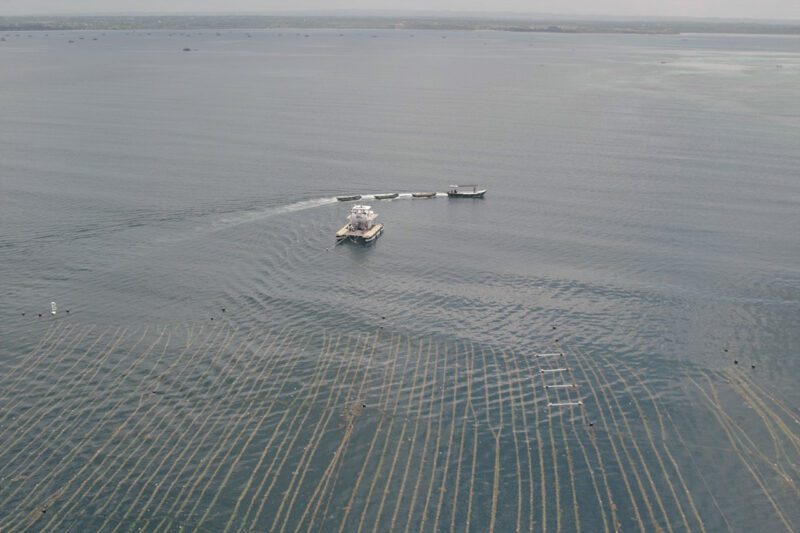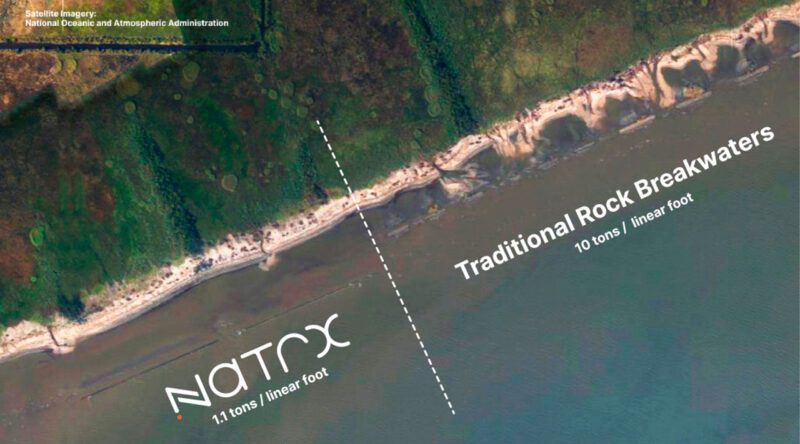From Survival Mode to Thriving
Rewiring (or unlocking) the MENA business mindset
How technologies can play a critical role in protecting and restoring marine health

Coastal Resilience solution provided by Natrx
Beneath the tranquil azure of our oceans lies a crisis of staggering proportions. Despite the fact that marine ecosystems are profoundly important for human well-being — providing us with food and medicine, buffering coastal infrastructure from severe climate events, serving as a carbon sink, and more — its protection is vastly underfunded.
In fact, researchers have estimated that SDG14: Life Under Water remains one of the most underfunded of all the UN’s Sustainable Development Goals, with a funding gap of US$174.5 billion per year.
It almost goes without saying that this funding gap, combined with the impact of industrialization, has led to the decline of all types of marine ecosystems of all types. According to the UNEP:
In this article, we outline five areas of Blue Ocean-Tech innovations that are turning the tide for the protection and restoration of these profoundly critical ecosystems.

Sea6’s large-scale seaweed farm
Why It Matters
Almost half of the world’s major cities are located within 50 km of a coast, exposing our social systems to hazards from sea-level rise and extreme weather events. Ecosystems like mangroves and coral reefs can naturally decrease both the frequency and severity of the impact of such hazards — but as they decline, so too do their protective services.
Examples of Start-Up Innovators Working to Help
Natrx (USA) uses proprietary wind and wave models to design programs for the restoration of degraded wetlands. Based on their analytics, they install low-carbon patented modular blocks (called ExoForms™) that allow for permeability of water and marine life, while increasing the on-shore resilience.

After Hurricane Laura; Courtesy of Natrx
Archireef (Hong Kong) makes 3D-printed Reef Tiles, to drastically improve coral survivorship rates up to 95%.
Dendra Systems (UK) remotely collects high resolution imagery using UAVs, analyses it using AI, and uses the resulting insights to power aerial seeding. They are in the works to restore both marine and terrestrial habitats, including 27.3M mangroves across 10,000 hectares in the UAE over the next 5 years.
Why It Matters
According to the NOAA, invasive species are one of the greatest threats to marine and coastal biodiversity globally. On both land and sea, they’ve been a major factor in 60% of extinctions that have been recorded by the IPBES. In marine environments, invasive species can spread through aquaculture, the aquarium trade, plastic pollution, navigational canals, and, most significantly, through shipping (through ballast water and biofouling, the accumulation of species like barnacles on surfaces where they are unwanted).
Examples of Start-Up Innovators Working to Help
Invasive Species Corporation (USA) discovers, develops, and deploys natural products to control invasive species. Existing products they sell address particularly damaging species such as the Zebra and Quagga Mussels in the Great Lakes, and Asian Carp in the Mississippi River.
Neptune Robotics (Hong Kong) robotic hull cleaning systems, powered by AI, to remove biofouling from trans-oceanic ships — therefore reducing the spread of non-native marine species across the globe.
Inversa Leathers (USA) creates high-performance leathers from highly invasive species, including Lionfish from the Gulf of Mexico and Dragonfin in the Mississippi River.
Why It Matters
You’re probably well aware that, for all our research and discovery efforts, there’s still a lot we don’t know about the ocean. It’s vast, deep, technically challenging, and politically complex. But in order to protect it and the services it provides, we have to understand it — whether to enact better policies, to keep it clean, to regulate fishing fleets more appropriately, to unlock blue carbon financing, or more.
Examples of Start-Up Innovators Working to Help
 PlanBlue (Germany) maps underwater ecosystems, using hyperspectral imaging, underwater navigation, and AI-enabled data processing. It provides insights on seafloor health, biodiversity, and blue carbon stores in marine habitats accurately, quickly, and cost-efficiently. Its focus is currently on the blue carbon and offshore wind markets.
PlanBlue (Germany) maps underwater ecosystems, using hyperspectral imaging, underwater navigation, and AI-enabled data processing. It provides insights on seafloor health, biodiversity, and blue carbon stores in marine habitats accurately, quickly, and cost-efficiently. Its focus is currently on the blue carbon and offshore wind markets.
Blue Ocean Gear (USA) prevents ocean-based tools (like fishing nets) from becoming deadly “ghost gear”. Using intelligent, connected buoys and supporting hardware, they can monitor the location and movement of any type of gear, as well as local environmental conditions, to assist fisheries and aquaculture operators in clean-up efforts.
Sofar (USA) has developed a marine sensing network, with hundreds of sensors deployed globally to make 1.5 million real-time observations of waves and other ocean variables. Their data allows maritime fleets to optimize their routes to decarbonize, and is also used by marine research institutions.
Why It Matters
Blue Foods — a broad term referring to wild-caught, farmed, and cell-cultivated marine-sourced foods — are often nutrient-rich, less carbon-intensive than terrestrial food sources, and contribute to the socio-economic wellbeing of coastal communities. Its demand is expected to roughly double by 2050. But to live up to its potential as a regenerative industry, we have to make sure it’s done right.
Examples of Start-Up Innovators Working to Help
Oceanfarmr (Australia) provides shellfish and seaweed farmers with the operational data and financing they need to farm regeneratively — cleaning the ocean, restoring marine habitat, and capturing CO2.
Finless Foods (USA) is making cell-cultured seafood alternatives to decrease pressures on wild populations, starting with tuna.

One of Sea6’s products, biodegradable bioplastics, which it makes using seaweed grown in its large-scale seaweed farms.
Sea6 Energy (India & Indonesia) has mechanised seaweed seeding and harvesting to scale its production beyond labour-intensive, near-shore farms. It has also developed novel applications for said seaweed: as biofertilisers, bioplastics, and biofuels, which further protect the ocean from pollution.
Why It Matters
The ocean already contains 16 times the amount of carbon in the terrestrial biosphere, storing around 38,000 gigatons (Gt) of carbon (1 gigaton = 1 billion tons). But climate change is weakening the ocean’s ability to absorb and store CO2, and acidifying it quickly, with negative implications for a myriad of marine organisms including corals and shellfish. Using a number of human-accelerated means (including Artificial Upwelling and Downwelling, Electrochemical Carbon Dioxide Removal, Alkalinity Enhancement, and Deep Sea Storage), some are looking not only to address these issues, but to also leverage the ocean’s scale to remove carbon dioxide from the atmosphere even further.
Examples of Start-Up Innovators Working to Help
Equatic (USA) is piloting its novel electrolytic process to stabilize CO2 permanently in the form of dissolved bicarbonate ions in seawater, in the form of solid mineral carbonates. The process also produces hydrogen as a co-product, holding promise for the green energy space.
Vycarb (USA) partners with mines, quarries, ports, municipalities, and coastal energy to autonomously and directly measure CO2 in the water, and then use that real-time data stream to transform CO2 into stable carbon forms for the ocean.
Captura (USA) uses a proprietary membrane and electrodialysis technology system to extract CO2 directly from the upper ocean, making it more alkaline so that the ocean will naturally absorb more CO2 from the atmosphere to rebalance.
In the world of environmentalism, it can sometimes seem like all hope is lost. But like most crises, the plight of our marine ecosystems today presents a profound opportunity for us to organize ourselves around positive acts of change, for all life on Earth.
Related Content
Comments
Deep Dives

Featuring
Clarisse Awamengwi
IE Correspondent
July 17 - 12:00 PM EST

Featuring
Russell McLeod
July 24 - 12:00 PM EST
RECENT
Editor's Picks
Webinars
News & Events
Subscribe to our newsletter to receive updates about new Magazine content and upcoming webinars, deep dives, and events.
Become a Premium Member to access the full library of webinars and deep dives, exclusive membership portal, member directory, message board, and curated live chats.
At Impact Entrepreneur, we champion fearless, independent journalism and education, spotlighting the inspiring changemakers building the Impact Economy. Diversity, equity, sustainability, and democracy face unprecedented threats from misinformation, powerful interests, and systemic inequities.
We believe a sustainable and equitable future is possible—but we can't achieve it without your help. Our independent voice depends entirely on support from changemakers like you.
Please step up today. Your donation—no matter the size—ensures we continue delivering impactful journalism and education that push boundaries and hold power accountable.
Join us in protecting what truly matters. It only takes a minute to make a real difference.
0 Comments